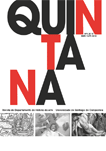The Gothic Line of Beauty: Motif and Medieval Aesthetics
Contido principal do artigo
Resumo
This contribution is concerned with the use and agency of line in Gothic and later art. At the creative height of the Gothic period in England, in the 13th and 14th centuries, curvilinear aesthetics lay at the heart of a number of creative achievements in the figurative arts and architecture. Thought needs to be given to how such linear aesthetics were understood and experienced historically. Starting with the affinity between ‘line words’ and textile manufacture, the paper moves to the idea of the ‘motif’ (or topic) as an originating point of invention. Some motifs or topics enjoyed a long history. One was the linea serpentinata, which here is tracked forwards from Dürer and Lomazzo to Hogarth, and then back to the so-called ‘ogee’ or double-curved S-line in Gothic art. The question of the continuity of gender and moral evaluation of line is finally placed in the wider and more enriching perspective of occasion or contextual understanding and experience.






